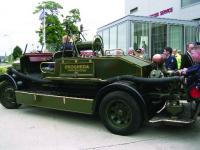Drogheda fire service and the Belfast blitz
Published in 20th-century / Contemporary History, Issue 4 (July/August 2011), Letters, The Emergency, Volume 19
One of the restored 1940s Merryweather fire engines that made the two-and-a-half-hour trip to Belfast in April and May 1941 at the commemoration in Drogheda on 15 May 2011.
Sir,—The article ‘When Dublin responded to blitzed Belfast’s Mayday’ (HI 19.3, May/June 2011) coincided with a commemoration of the event held in Drogheda on 15 May. The mayor of Drogheda, Alderman Paul Bell, hosted his counterparts from Dublin and Belfast at a tree-planting ceremony and the unveiling of a plaque at the fire station in Drogheda, followed by a service in the local Augustinian church. Other guests included the families of the Drogheda firemen of over 60 years ago and John Gray from Dundalk (at 90 surely the oldest survivor of the crews who assisted Belfast on those fateful nights). Fire engines from the 1940s were also driven through Drogheda.
My own involvement in these events stems from the fact that my father, John Sheils, was the first officer and driver of the engine that went to Belfast in April and May 1941. The other crew were Superintendent Dan Lennon, Firemen Michael Moore, ‘Synnott’ Craven, Peter Farrell, Paddy McEnaney, Sammy Gallagher and Paddy Harrison. These men were employees of Drogheda Corporation and only part-time firemen. When they were called to fight a fire, their Corporation employment ceased for the duration and they were paid the fireman’s rate. My father complained that this was less than their normal rate of pay.
The engine was a Merryweather, the most common in use at that time. Interestingly, it was painted green, the only engine in the world so painted, I suspect. This came about because sometime TD and frequent mayor of Drogheda Laurence (Larry) Walsh insisted that his town’s engine should not be painted in a livery he associated with the British Empire! He took the same view of the Corporation’s ceremonial robes. My father recalled that not all of the citizens of Belfast were enthusiastic about the arrival of the green engine!
The trip to Belfast took two and a half hours, which averages out to a speed of approximately 30mph/45kph. Obviously this was a much longer journey than was usually undertaken and not without its hazards. The roads in April were frosty and the engine’s heavy ladder and the pumping gear loaded to the rear made it difficult to control, especially when cornering. My father and Superintendent Lennon sat in an open cab, protected only by a windscreen. The other men sat on the outside of the engine, no doubt holding on to the ladder for dear life. All were undoubtedly cold and uncomfortable. The Drogheda engine reached Belfast before the Dublin ones, which explains why ‘Drogheda . . . slept soundly as we sped northward’—the Drogheda fire service was already in Belfast!
I am uncertain of the duration of their stay in Belfast but I think they returned late the next day. They worked at an air-raid shelter that had taken a direct hit. My father was a veteran of the First World War, but even he spoke of the trauma he suffered as a result of this work among the mangled remains, especially those of children. It must have been much worse for the other men, who had had no preparation for what awaited them in the bombed city. There is also a report that Sammy Gallagher was injured in the course of their work. It is to be noted that the plaque unveiled by Mayor Bell contains the names of the public representatives who were present at its unveiling but not of the firemen whose bravery occasioned it. I hope to remedy this omission in the near future.—Yours etc.,
JOE SHEILS
Drogheda
















